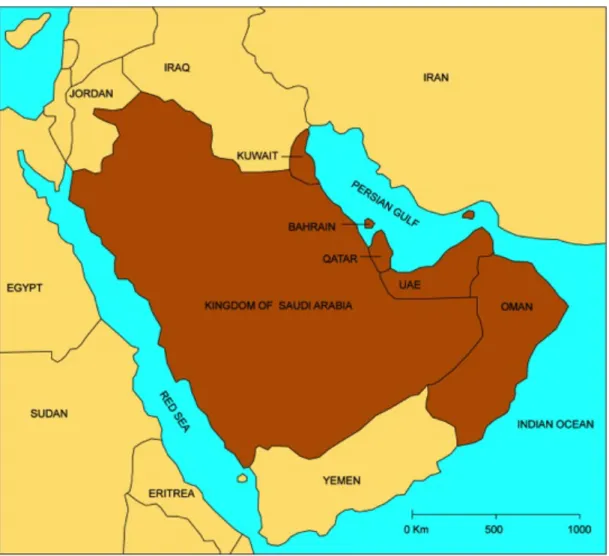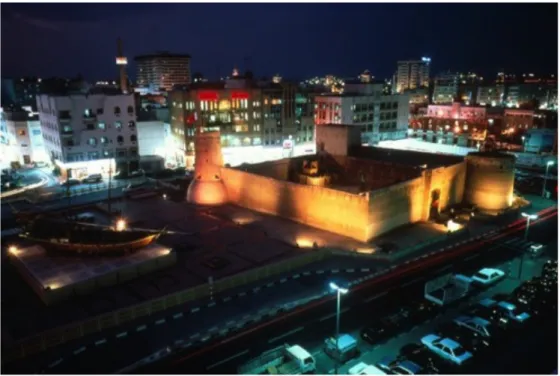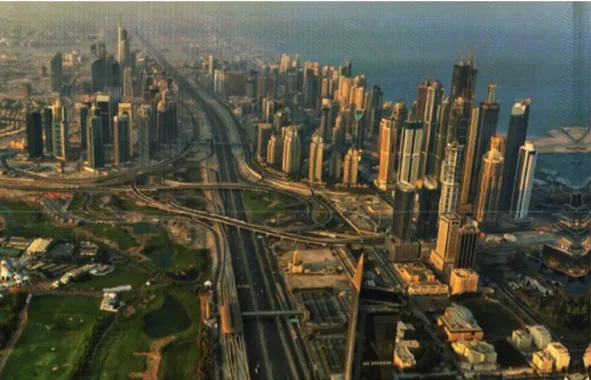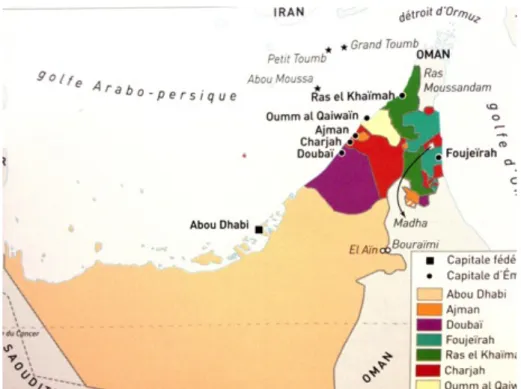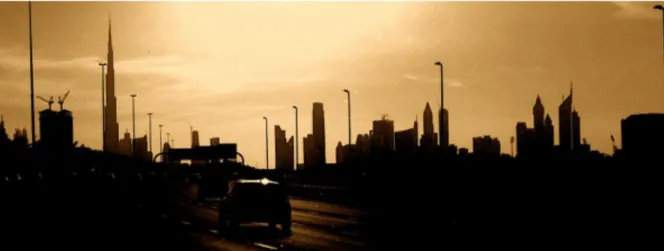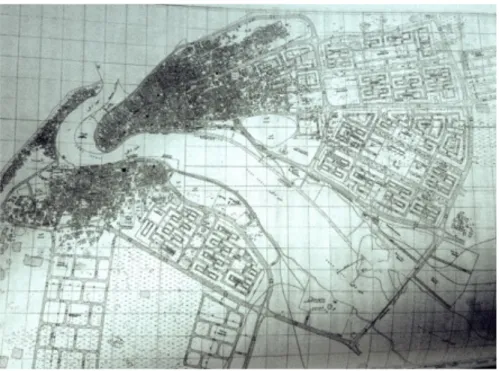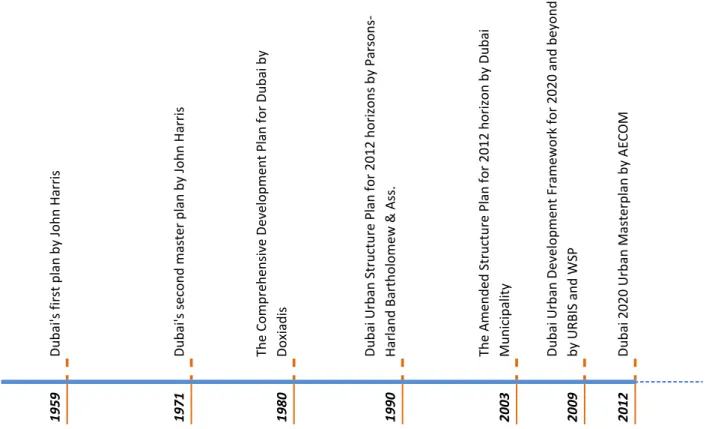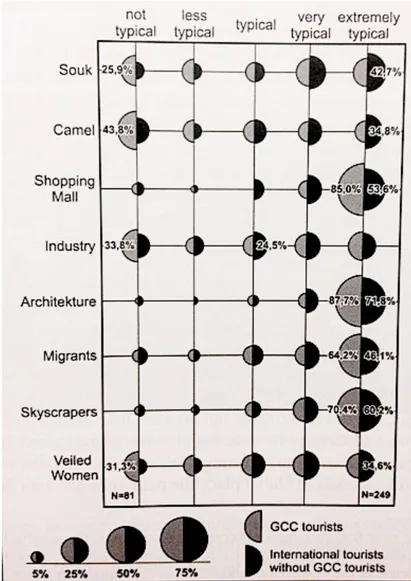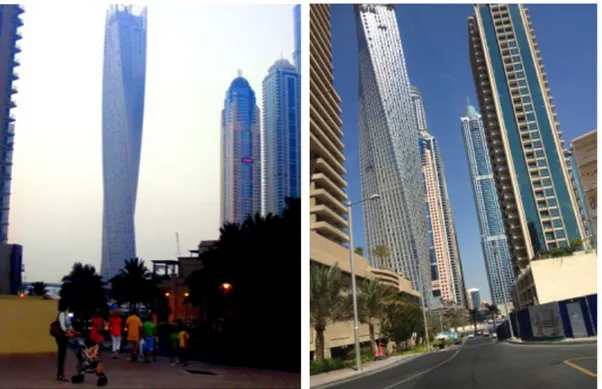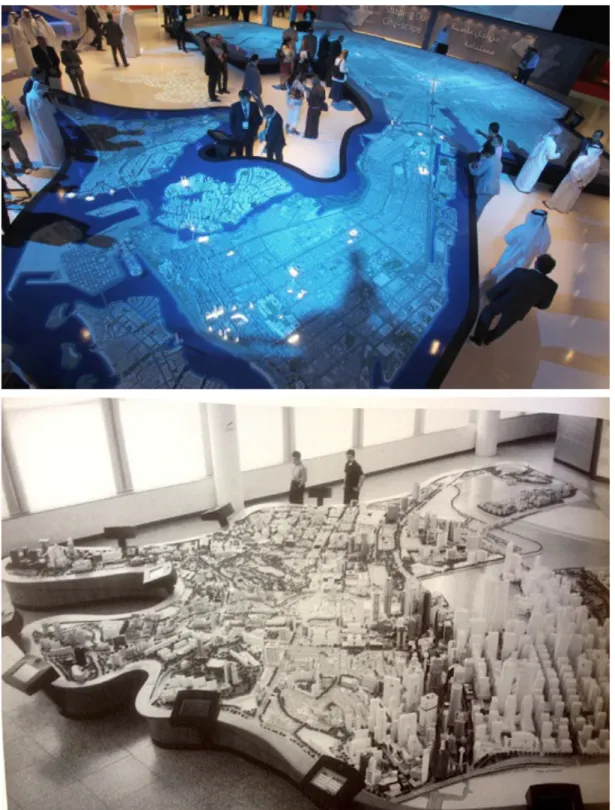Université de Liège
Faculty of Applied Sciences
Urban Megaprojects-based Approach in Urban Planning:
From Isolated Objects to Shaping the City
The Case of Dubai
PHD Thesis Dissertation
Presented by Oula AOUN
Submission Date: March 2016
Thesis Director:
Jacques TELLER, Professor, Université de Liège
Jury:
Mario COOLS, Professor, Université de Liège
Bernard DECLEVE, Professor, Université Catholique de Louvain
Robert SALIBA, Professor, American University of Beirut
Eric VERDEIL, Researcher, Université Paris-Est CNRS
Kevin WARD, Professor, University of Manchester
ACKNOWLEDGMENTS
My acknowledgments go first to Professor Jacques Teller, for his support and
guidance. I was very lucky during these years to have you as a thesis director.
Your assistance was very enlightening and is greatly appreciated. Thank you for
your daily comments and help, and most of all thank you for your friendship,
and your support to my little family.
I would like also to thank the members of my thesis committee, Dr Eric Verdeil
and Professor Bernard Declève, for guiding me during these last four years.
Thank you for taking so much interest in my research work, for your
encouragement and valuable comments, and thank you as well for all the travel
you undertook for those committee meetings.
This research owes a lot to Université de Liège, and the Non-Fria grant that I
was very lucky to have. Without this funding, this research work, and my trips to
UAE, would not have been possible. My acknowledgments go also to Université
de Liège for funding several travels giving me the chance to participate in many
international seminars and conferences.
To my friends and colleagues in Ulg – Lina, Maryse, Christine, Juan, Miranda,
Shady, Mario – thank you for all the conversations and stories; in one way or
another you will all figure prominently in my memories of this thesis. Many
thanks to Olivier Borsus for providing all types of references I’ve asked for.
Thanks to those who contributed in various ways to this document: Antonella,
Hussein, Rozana for their help in the cartographic work, and my brother Elias
for proofreading and David Kelly for the final editing.
To all friends and relatives in Dubai, especially my cousin Rana, thank you for
facilitating my site work, and for introducing me to the many key persons there
who helped me in my interviews.
My thanks go to my family, my parents Bernadette and Georges, and my
step-parents Aida and Henri. Thank you for your support and your unconditional
love, and thank you for taking care of my little family all the times I was busy
working on my thesis.
To my little Henry, thank you for your patience. I will never forget your
welcoming baby smile when you see me, each time I traveled to participate to
seminars or to do site works. And sorry for all the times you asked me to play
with you and I told you that I was busy working.
Last but not least, to my friend, colleague, mentor and my second half, Jihad,
thank you for your support and love. Thank you for always being there for me.
This thesis is also dedicated to you.
Abstract
Urban megaprojects are at the core of cities’ re-imaging and marketing. As
large-scale development projects, they are considered as a globalization product, marked
by a search for spectacle and visibility. In Dubai, UMPs have constituted in recent
years the main tool in drawing a city image that aims to compete with the world
global cities. Through UMPs, an economy based on spectacle and fascination is
being deployed, within a complex system of governance that encompasses family
ties, business logic and individualist visions. UMPS are not exceptions or isolated
developments, they are in Dubai, a mean through which the city is expanding and
being managed.
UMPs are here the backbone public planning instrument to what we can call a
UMPs-based approach to planning and development. Paradoxically, it is these very
large projects, usually associated to urban fragmentation that allow, through their
form and processes, the emergence of forms of regulation that articulate actors,
institutions, interests, resources, spaces and scales.
These adaptations and negotiations are orchestrated in a strategic pilotage manner,
through informal, often unveiled ad hoc regulatory spaces. The ultimate goal is to
ensure a certain synchronization between temporalities and project through a
continuous logic of complementarity and competitiveness.
TABLE OF CONTENTS
INTRODUCTION
Chapter 1: Specific urban history, particular governance and a customized
expertise as main factors contributing to the emergence of Dubai’s UMPs
1 HISTORY AND PARTICULAR URBAN EXTENSION 18
1.1# GEOGRAPHIC#LOCATION#AND#OPEN#POLICIES#...#23#
1.2# THE#OIL#DISCOVERY#...#26#
1.3# TOWARDS#A#METROPOLIS#CITY#...#29#
1.4# METROPOLIZATION#AND#NEOLIBERAL#URBAN#POLICIES#...#30#
1.5# DUBAI’S#DEVELOPMENT#AND#URBAN#TOOLS:#THE#URBAN#MEGAPROJECT#AS#MAIN#ENGINE# OF#DUBAI#MODEL#...#31#
1.5.1# Provision+of+infrastructure+...+32#
1.5.2# Schematic+and+Master+Plans+...+32#
1.5.3# Urban+Megaprojects+as+urban+tool+...+37#
1.5.4# The+fascination+...+39#
1.5.5# Metropolization+and+Space+Commodification+...+43
#
2 ACTORS AND GOVERNANCE SYSTEM AS MAJOR CONTRIBUTORS TO THE EMERGENCE OF MEGAPROJECTS 45
2.1# DUBAI#PORTRAYED#AS#A#NEOLIBERAL#CITY#...#46#
2.2# THE#THREE#SCALES#IN#DUBAI’S#GOVERNANCE#...#47#
2.2.1# The+Sheikh+(governor)+as+a+unique+reference,+and+the+corporate+governance+style+47# 2.2.2# The+Municipality,+Free+Zones+and+the+multitude+of+authorities+...+51#
2.2.3# The+parastatals,+governmentMcontrolled+developers,+and+the+lack+of+limits+between+ public+and+private+...+54#
2.3# BETWEEN#UMPS#AND#THE#FINANCIAL#SECTOR#...#55#
2.4# UNVEILING#THE#ROLES#OF#VARIOUS#ACTORS#IN#THE#REALEESTATE#SECTOR#...#57#
2.5# PUBLICEPRIVATE#SYNCRETISM#AND#‘ZERO#POLITICS’#...#59#
3 LACKING LOCAL EXPERTISE – INTERNATIONAL FIRMS AS MAIN ACTORS. 63 3.1# ICFUP,#ACTORS#OF#A#NEW#MODEL#OF#URBAN#PRODUCTION#...#67#
3.2# INTERACTIONS#BETWEEN#CONTEXTUAL#ELEMENTS#AND#OPERATIONAL#MODE;#THE# INTERNATIONAL#CONSULTANCY#FIRMS#AS#ANALYTICAL#FRAMEWORK#...#68#
3.2.2# Coping+with+a+particular+regulatory+context+...+72#
3.2.3# Operating+in+the+context+of+a+specific+urban+product:+the+megaprojects+...+75#
3.2.4# Between+global+and+local:+searching+for+references+...+76#
3.3# BETWEEN#ARCHITECTURAL#AND#ENGINEERINGEARCHITECTURE#FIRMS:#TOWARD#A# TYPOLOGY#...#78#
3.3.1# On+communication+and+mobility+...+79#
3.3.2# On+the+differences+in+structure+...+80#
3.3.3# Different+methods+of+selfMevaluation+and+review+...+83#
4 CONCLUSION 85
Chapter 2: Dubai’s Megaprojects from isolated objects to shaping the city: A
morphological analysis
1 KEY COMPONENTS OF DUBAI UMPS AS PRESENTED IN THE LITERATURE: DRAWING A REPRESENTATION 92 1.1# CHARACTERIZING#MEGAPROJECTS#BY#THEIR#GOVERNMENTERELATED#CHARACTERISTICS#93# 1.2# CHARACTERIZING#MEGAPROJECTS#BY#THEIR#MORPHOLOGICAL#ASPECTS#...#95#2 ANALYSING DUBAI URBAN MEGAPROJECTS BASED ON AN EMPIRICAL APPROACH 98 2.1# THE#MASTER#DEVELOPERS#...#103#
2.2# THE#FREE#ZONES#...#107#
2.3# THE#LOCATION#OF#MEGAPROJECTS#...#110#
2.4# THE#ROLE#OF#UMPS#AS#EXPANSION#ENGINE#...#113#
2.5# THEMING#AND#SYMBOLISM#...#117#
2.6# RECORDS#...#120#
2.7# CONNECTION/DISCONNECTION#TO#OR#FROM#THE#CITY#...#121#
3 UNDERSTANDING MEGAPROJECTS THROUGH THEIR MORPHOLOGY 125 3.1# URBAN#ANALYSIS#APPROACH#AND#METHODOLOGY#...#126#
3.2# SELECTION#OF#CASE#STUDIES#...#130# 3.2.1# Descriptive+analysis+...+132# 3.3# INTERPRETIVE#ANALYSIS#...#140# 3.3.1# Iconicity,+through+elements+of+urban+design+...+140# 3.3.2# Accessibility,+analysed+through+connectivity+aspects+...+142# 3.3.3# Divisibility,+analysed+through+phasing+and+management+aspects+...+144# 4 CONCLUSION 147
Chapter 3: Urban Megaprojects in Dubai as a Specific Urban Instrument
1 UMPS BETWEEN URBAN PLANNING AND URBAN DESIGN 154
1.1# UMPSEBASED#APPROACH#A#HYBRID#OF#URBAN#PLANNING#AND#URBAN#DESIGN#...#154#
1.2# COMPARING#UMPSEBASED#APPROACH#TO#SIMILAR#PHYSICAL#APPROACHES#...#160#
1.3# UMPS#AS#PLANNING#INSTRUMENTS:#ROLE#AND#CHALLENGES#...#164#
2 UMPS AS AN INSTRUMENT TO MITIGATE COMPLEXITY 169 2.1# FACING#THE#COMPLEXITY:#PILOTAGE#OR#PROJECT#ENGINEERING#...#170#
2.2# URBAN#ENGINEERING#...#170#
2.3# STRATEGIC#‘PILOTAGE’#...#172#
2.4# ANALYSING#DUBAI#MARINA#AS#CASE#STUDY#...#174#
2.4.1# Historical+description+of+the+project+...+174# 2.4.2# Project’s+actors+...+177# 2.4.3# Pilotage+practices+in+each+project+...+178# 2.5# COMPETITION#OR#COMPLEMENTARITY#...#184# 2.6# BETWEEN#THE#PROJECT#SCALE#AND#THE#CITY#SCALE#...#186# +
Conclusion
List of figures
Fig 1.1: GCC countries, Yemen not being part of the council page 18 Fig 1.2: Al-Fahidi Fort, one of the remaining old buildings in Dubai page 19 Fig 1.3: Al Fahidi Fort transformed into Dubai Museum-2013 page 19
Fig 1.4: Aerial view of Dubai – 1951 page 20
Fig 1.5: Sheikh Zayed Road page 21
Fig 1.6: A sketch map of Dubai – 1822 page 23 Fig 1.7: The seven emirates constituting the United Arab Emirates page 24 Fig 1.8: Rashid Port at the creek’s mouth page 26 Fig 1.9: The urban expansion of Dubai page 27
Fig 1.10: Dubai skyline page 27
Fig 1.11: Dubai’ first master plan by John Harris in 1959 page 32 Fig 1.12: Chronology of the various plans for Dubai city page 33 Fig 1.13: Dubai Urban Structure Plan for 2012 and beyond page 34 Fig 1.14: Amended Master Plan for 2012 horizon page 35 Fig 1.15: Dubai modern infrastructure page 37 Fig 1.16: Typical representations of Dubai by international tourists page 39
Fig 1.17: Burj al Arab page 40
Fig 1.18: Burj Khalifa page 41
Fig 1.19: The members of the Executive Council in 2015 page 49 Fig 1.20: Official classification of departments, councils and authorities page 53 Fig 1.21: Major parastatals in their self-promotion page 56
Fig 1.22: Dubai twisted tower page 58
Fig 1.23: Models for Abu Dhabi 2030 vision and Singapore developments page 64 Fig 2.1: Representation of Dubai UMPs in the literature page 89 Fig 2.2: Locations and names of the 36 surveyed megaprojects page 96 Fig 2.3: Dubai Lifestyle City’s Masterplan page 97 Fig 2.4: The megaprojects in Dubai, a specific urban composition page 98
Fig 2.5: The three axes of analysis page 99
Fig 2.6: Nakheel islands projects page 101
Fig 2.7: Dubai parastatal developers page 103
Fig 2.8: Business Bay page 105
Fig 2.9: Silicon Oasis page 106
Fig 2.10: Dubai Financial District page 106
Fig 2.11: The three territories of Dubai page 109
Fig 2.13: Reclaimed islands and main expansion axis page 113
Fig 2.14: Dubai 2020 land uses page 121
Fig 2.15: The three aspects of the morphological analysis page 125 Fig 2.16: Location of selected case studies in Dubai page 127 Fig 2.17: A master plan for Dubai Marina page 129 Fig 2.18: Connection points in Dubai Marina page 130 Fig 2.19: Aerial view of Dubai Marina page 130 Fig 2.20: A master plan for City of Arabia project page 131 Fig 2.21: Connection points in City of Arabia page 132 Fig 2.22: Aerial view of city of Arabia page 132
Fig 2.23: a master plan for JLT page 133
Fig 2.24: Connection points in JLT page 133
Fig 2.25: Aerial view of JLT page 134
Fig 2.26: A master plan for Green Community West page 135 Fig 2.27: Connection points in Green Community West page 136 Fig 2.28: View inside Green Community West page 136
Fig 2.29: The four lakes in JLT page 142
Fig 3.1: The land committed to UMPs before 2008 page 154 Fig 3.2 Map of existing and planned megaprojects page 155
Fig 3.3: Roads put on hold page 163
Fig 3.4: Palm Jebel Ali, Palm Jumeirah and the World Islands in 2005 page 164
Fig 3.5: Bluewaters Island page 165
Fig 3.6: Dubai Marina in 2012 page 172
Fig 3.7: First plan of Dubai Marina dating back to 1999 page 173 Fig 3.8: Different sub-projects constituting Dubai Marina in 2014 page 174
Fig 3.9: JBR towers page 177
Fig 3.10: JLT towers page 178
Fig 3.11: The ‘tallest’ block in the eastern part of Dubai Marina page 179 Fig 3.12: Pedestrian promenade in Dubai Marina page 182
List of tables
Table 1.1: Surveyed firms, divided into Architecture and Engineering-
architecture firms. page 66
Table 2.1: The developers of Dubai UMPs page 100
Table 2.2: Location of megaprojects page 110
Table 2.3: The distribution of uses in surveyed megaprojects page 115 Table 2.4: Water and green bodies in Dubai’s UMPs page 116 Table 2.5: Projects’ information brief page 137 Table 2.6: Table briefing the iconicity aspects in the four case studies page 138 Table 2.7: Table briefing the accessibility aspects in the four case studies page 139 Table 2.8: Table briefing the divisibility aspects in the four case studies page 141 Table 3.1: Limits between urban planning and urban design page 153
Introduction
Cities are increasingly at the centre of economic growth strategies and are considered a platform for economic competition, mainly through large and particular urban interventions. Frequently, these interventions involve large urban developments, often called urban megaprojects. In the context of inter-city competition, urban megaprojects are seen as a vehicle for revitalization, restructuring and attraction; they have been described as ‘one of the most visible and ubiquitous urban revitalization strategies pursued by city elites in search of economic growth and competitiveness’ (Swyngedouw et al., 2002). They are at the core of economies of fascination (Schmid, 2009; Bryman, 1999), spectacle and city marketing (Ashworth, 2009; Avraham, 2002; Eshuis & Klijn, 2012).
Similar to the large monuments and engineering masterpieces of the nineteenth century and the skyscrapers of the early twentieth century, megaprojects are icons of managerial and technical prowess in the production of the contemporary city. Their large scale and functional complexity provide them a significant cognitive power that puts them at the center of current strategies of metropolization in many cities around the world. In this context where city politics have shifted from regulation and welfare issues to re-imaging and marketing the city, large urban development projects are seen as a product of a ‘shift to urban entrepreneurialism’ relying on public-private partnerships for promoting urban growth and development (Harvey, 1989).
Defining Urban Megaprojects (UMPs)
Megaprojects are not new (Lehrer & Laidley, 2008; Orueta & Fainstein, 2008); it is possible to identify undertakings on this scale in earlier periods that display a variety of forms and contents. Whether in the context of post- World War II reconstruction or of the mega structures movement of the 1960s, megaprojects were often symbolic of social amelioration and technological progress.
The beginning of the 1990s witnessed a new type of large project characterized by high complexity and cost and requiring complicated financial and partnership procedures. In their contemporary version, urban megaprojects are flexible and diverse rather than singular and monolithic (Lehrer & Laidley, 2008; Olds, 2002), and encompass tourism, sports, finance, leisure and residence functions. In most cases, these urban megaprojects include one or more famous architecture signature buildings.
Terms used to designate urban megaprojects have varied according to place, time and author; examples include ‘urban mega-projects’ (Olds, 2002), ‘large-scale urban projects’ (Lehrer & Laidly, 2008), ‘entrepreneurial urban projects’ (Ben-Joseph, 2009), ‘global urban projects’ (Marshall, 2003), ‘large urban development plans’ (Sager, 2011), ‘urban complex projects’ (Arab, 2004), ‘complex real-estate projects’ (Priemus et al., 2008), and in more overstated appellations, ‘cities within a city’ (Samarai & Qudah, 2007), and ‘satellite cities’1 (Percival & Waley, 2012; Abaza, 2011).
Clearly, exceptional size is a major criterion in the definition, followed by the mixed-use and the ‘integrated’ aspects of such projects. Some authors focus on the complexity side of the projects’ contents and contexts (Orueta & Fainstein, 2008; Premius et al., 2008), others on their linkage to globalization where the projects transcend local conditions and adhere to universal codes (Marshall, 2003), while yet others highlight the technological aspect mobilized within these projects (Brown et al., 2009).
In analysing megaprojects, infrastructure projects such as large airports, metro and ports projects are often included. In many essays as well, the term ‘megaproject’ includes high towers, and single buildings. It is often used in the media as well as the scientific literature to designate different objects. Therefore, it is important to define what we mean by ‘megaproject’ in the context of this research.
First, the term as used in this research does not include large-scale urban projects that are strictly limited to the implementation of an infrastructure. In fact, one can find a large number of infrastructure projects that require huge budgets and high technical prowess and that generate consequently a high financial risk (Flyvbjerg et al., 2002).
1
However, they are very different in their development, design and implementation from multifunctional urban projects where the project’s contents and uses and the political dimension have a much greater bearing on the development of operations. Second, we differentiate, following Arab (2004), these megaprojects from large architectural projects and "agglomeration" projects or "territory" projects. Although architectural projects can have an undeniable symbolic and iconic dimension and can mobilize significant funds, they do not have the complex implementation dimension that is intrinsic to urban projects, with all their implications in terms of complexity of actors and political consequences.
Similarly, "agglomeration" projects or "territory" projects, such as strategic metropolitan or regional development projects, are different from urban megaprojects. They lack direct connection with the site realities of a localized operation. Remaining on the side of strategic choices, they often do not have to deal with operational challenges. The most significant of these challenges is the moving complexity of an urban environment, its actors’ whims and interests and its changing economic dynamics.
The most typical characteristics of megaprojects identified in the literature (Frick, 2005; Priemus et al., 2007, 2008) are termed the ‘6 Cs’: Colossal in size and scope; Captivating because of the project’s size, engineering achievements and possibly its aesthetic design; Costly, in that costs are typically underestimated and increase over the life of the project; Controversial, as project participants negotiate funding and mitigation packages, engineering and aesthetic design plans, and pursue construction; Complex, a factor which breeds risk and uncertainty in terms of design, funding and construction; and laden with Control issues related to who are to be the key decision-makers.
Olds (2002) considers, based on an analysis of megaprojects in Europe, North America, Asia and Australia, that these have many similarities: they are modelled on each other; developed and planned by architects, planners and other experts who have experience of working on previous or on-going megaprojects around the world; developed with both explicit and implicit internationalization strategies in mind; marketed to overseas firms and high income individuals for subsequent lease or purchase; and designed to symbolize a global urban ‘utopia’ for the twenty-first century (Olds, 2002).
The main characteristic of this type of project is its complexity, especially in terms of actors involved and the various difficulties encountered at the implementation level.
These are operations that bring together a large number of actors from different disciplines and cultures. The role and status of many of these actors, in the fragmented and complicated process of the project, are of necessity only temporary and partial. The arrangements and implementation often require complex and particular measures in order to successfully cope with regulatory frameworks.
Similarly, securing funding and allocating responsibilities among stakeholders is not a simple task. This is why many authors see financial and political risk as inherent in this type of project and among its main characteristics (Flyvbjerg et al., 2003; Premius et al., 2008; Bourdin, 2002; Salet et al., 2013).
The megaproject for us is a large urban2 development project that is specific for its size, complexity and duration. While localized, it is inscribed in a specific dynamic of metropolitan - even global - development at a broader scale. Thus it is related, for some scholars, to the emergence of the neoliberal city (Swyngedouw et al., 2002; Sager, 2011) or, for others, in a less trenchant analytical tone - to metropolitan development and its needs and strategies (Salet and Gualini 2006; Bourdin and Prost, 2009).
Urban Megaprojects, an ‘actually existing’ neoliberalism tool
Despite criticism concerning their costs, risks and impacts, UMPs are becoming increasingly a common urban tool in various contexts. However, the studies on UMPs do not correspond to their expansion worldwide. There are many successful studies on megaprojects; however, this subject is still marked by imprecision and ambiguity.
2
We recognise that the word ‘urban’ in connection with a project connotes a complexity of actors, ranging across both private and public actors, and acknowledge that it cannot carry the same meaning in the Dubai context. Barthel (2008) considers that the word ‘urban’ used in European contexts cannot be applied to the Arab world in this sense, where usually megaprojects are governed and piloted by developers and rulers. However, in this text, the adjective ‘urban’ is used to differentiate the megaprojects from infrastructural projects.
The approach adopted in individual researches is often one based on case studies analysed from the angle of actors’ role, the new contexts of globalization (Altshuler & Luberoff, 2003; Barthel, 2008, 2010; Lehrer & Laidly, 2008; Salet, 2007; Shatkins, 2008; Swyngedouw et al., 2002), or the management of these projects (Browne et al., 2009). They are also analyzed through their evolution in history (Orueta & Fainstein, 2008; Lin, 2007), their morphology, impact, costs, and the social issues they imply (Carmona, 2006; Fainstein, 2008, Flyvbjerg et al., 2002; Salet et al., 2013; Flyvbjerg, 2005; Marshall, 2003; Jia et al., 2011; Olds, 2002; Priemus & Flyvbjerg, 2007; Kim et al., 2009; Priemus, 2008; Priemus et al., 2008; Shatkins, 2011; Van Marrewijk et al., 2008).
The analytical framework of the production of megaprojects in the scientific literature is mostly dominated by approaches that link, almost systematically, the emergence of these new urban objects to the dynamics of globalization and neoliberalism. These analyses are often based on theories of political economy. These theories emphasize the impact of changes in production modes, financialization3 and the dominant role of private actors, factors that are put forward to explain the contemporary changes in cities’ production processes, and therefore in the emergence of UMPs.
Considered as expressions of neoliberal urban planning policies, urban megaprojects are understood in the light of concepts such as ‘glocal states’ (Swyngedouw 1996) and ‘glocal fixes’ (Brenner & Theodore 2002). UMPs became specific tools seeking to attract international capital and investments through space-based interventions.
The majority of these projects, be it in Europe, in America, in Southern Asia or in the Arabic world, often portrayed as prototypes (Marshall, 2003), have many similarities. These similarities can be seen at the morphological level, in the financing modes or the public-private partnerships they involve, and more particularly in the objective of attracting multinational users and investments in a context of inter-city competition (Fainstein, 2008; Lehrer & Laidly, 2008; Diaz & Fainstein, 2008; Barthel, 2010).
3
Financialization’ is defined in ‘Oxford Dictionaries’ as the process by which financial institutions, markets, etc., increase in size and influence.
Despite these similarities, urban megaprojects are at the same time the product of specific factors such as sociopolitical and economical contexts and professional milieus. They are ‘emerging urban forms powerfully shaped by place-specific geographies, cultural preference and social structure’ (Shatkins, 2011).
Indeed, in the literature, urban megaprojects are examined through two different angles. From one side, they are considered as globalized city fragments, given the internationalization of capital and the circulation of images and models. These images and models are the results of the globalization of ideas, the standardization of norms, the important role of mobile professionals and the new ‘global’ practices of increasingly diverse populations.
From the other side, megaprojects are considered as specific products of particular contexts. They are at the same time products of specific local governances and the reflection of local norms and references. As manifestations of neoliberal urban policies, urban megaprojects transform, adapt or mutate in different contexts (Brenner & Theodore, 2002).
In fact, neoliberal urban policies are often analysed in relation to a geographical context, the particularities of which filter and transform the neoliberal logic (Hackworth & Moriah, 2002). It is in light of these observations that many scholars have defined an ‘actually existing’ neoliberalism in order to designate the important variations the interpretation and application of this concept have to undergo in each city. Based on this literature on contingency in neoliberal urban policies, UMPs can be understood as globalization’s fragment as well as the product of a local context.
Consequently, despite UMPs having become a worldwide phenomenon, the plethora of economic, cultural and political factors varies between one context and another. In the Arabic world, for example, UMPs have a particular dimension. They constitute a major component within the development and extension of cities. In Dubai, the focus of the present research, UMPs are at the core of economic policies adopted by urban actors.
‘Fascinating’ UMPs in Dubai: a lever for a new urban planning and
development approach
UMPs, along with rapid urban growth, have transformed Dubai in the last two decades. Scholars describe this transformation as a shift from a fishing and trading village to a cosmopolitan, regionally significant twenty-first century city, that is a leading tourism, mass communication, transit and finance hub, and a city present on the world stage as global (Pacione, 2005; Lavergne, 2002, 2009; Malty & Dillon, 2007; Haines, 2011; Acuto, 2010, 2011; Chu, 2007). It is this rapid evolution, from pre-industrial to industrial and then post-industrial center (Acuto, 2010; Pacione, 2005), moving from basic economic activities to an oil-based economy and then to a diversified economy, that distinguishes Dubai as a ‘product of a super-fast urbanism’ (Bagaeen, 2007, p.174). A number of factors have contributed to this transformation. Some are related to Dubai’s strategic location and others to the ‘openness politics’ adopted by the city’s rulers.
Its spectacle and monumentality have prompted descriptions of the city as in a ‘frantic quest for hyperbole’ (Davis, 2007, p.54), and as a place where ‘superlatives had become a way of life’ (Walters et al., 2006, p.79). In only a decade, Dubai has built for itself a city map and skyline that are recognized worldwide. The spectacle in architecture can be seen through artificial islands, record-breaking towers, and the high number of large-scale developments. Dubai is often portrayed as a product of neoliberalism, since its policies are mainly oriented toward the market, with extreme measures such as elimination of taxes and deregulation in the context of urban and economic frameworks.
In this context, urban megaprojects are not only a constitutive part of the city’s branding policies aiming at creating a city label and image contributing to the city’s development and extension, they also contribute to the deep transformation of its urban morphology. In the last fifteen years, these megaprojects, built at a record speed, have profoundly modified the urban landscape in Dubai. They have been also the most tangible expression of the city’s metropolization, or what has been called the ‘Dubai miracle’ (Hardy, 2008; Walters et al., 2006; Lasnier & Chancel, 2010).
The city’s general urban morphology can be compared to an assemblage of megaprojects, implanted in the city either individually or through agglomerations. Located in different parts of the city, close to the urban fabric that existed before the construction boom and far from the old centre towards the inland desert, Dubai’s
megaprojects do not follow clear urban expansion logic. The result is a fragmented urban fabric that looks more like an uncompleted urban puzzle.
This urban fragmentation is not only a reflection of a specific real estate market or particular development agendas, it reflects a socio-cultural system that is also marked by a social fragmentation (Kanna, 2011). In fact, even if some authors interpret urban fragmentation strictly as a spatial and geographical phenomenon (see for example Burgess, 2005), some others consider that elements of urban fragmentation encompass spatial, socio-spatial, political and economic issues (Navez Bouchanine, 2002; Bénit et al., 2007).
This amplification of many aspects such as seeking metropolization, the plethora of neoliberal politics, the rapidity and particularity in urban transformation and extension, the impact of fascination, the abundance of capital, the power and monopoly of the urban actors all contribute to portray Dubai as a place that makes more visible dynamics that may be less visible in other contexts.
Even if Dubai shares many similarities with other GCC cities, a set of particularity characterizes its history, its socio-political system and its economy. Since the early beginning of the city, in the nineteenth century, Dubai rulers were known for their openness to other cultures, their ambitious plans for their city, and their ability to centralize and control all aspects of urban and political life.
Many authors have analysed a number of Dubai’s most spectacular urban megaprojects, some considered to be the icons of Dubai’s circulated image, like the Palm Islands and the World Islands (Picon-Lefèvre, 2013; Elsheshtawy, 2004; Jensen, 2013). There has also been a focus on its free zone megaprojects (Malty & Dillon, 2007), and Dubailand Megaproject (Walters et al., 2006).
While the Dubai experience has attracted many authors, there is no text that focuses exclusively on megaprojects. Dubai’s UMPs have been examined in some studies without constituting the main object of analysis, being treated instead along with governance aspects or through an architectural perspective. There is no scholarly work that aims to analyse the characteristics of Dubai UMPs with reference to a sufficiently large database. Moreover, it is important to underline the lack of systematic analyses that examine the role of the megaprojects within the broader urban dynamics of the city.
We consider that the particularity of Dubai’s UMPs cannot be examined in isolation from the urban and global dynamics of the city and its actors. Indeed, from one side, Dubai is extending through megaprojects, and from the other side, the city is governed as well by megaprojects. Dozens of megaprojects constitute the heart and the development engine of various parts of the city.
Moreover, the numerous real estate developers affiliated to the monarchical political system, a plethora of financial policies, land control and strategic plans all implicate and are orchestrated through megaprojects.
Therefore, the particularity of our study lies in analysing the UMPs within the totality of the system inside which they exist. UMPs, in their morphological and managerial dimensions, will be studied as a product of a particular socio-political system, and of a network of actors that connects political leaders, real estate companies, regional developers, and international consultancy firms.
We believe that megaprojects cannot be understood as isolated interventions linked to various culturally and economically globalized networks, but have to be examined as both a product and a catalyst of local urban dynamics. They also cannot be understood in isolation from interrelations between actors in terms of their specificities and roles, and the manifestation of these in terms of physical and morphological characteristics as well.
Based on all that, we argue that Dubai urban megaprojects, as reflections of globalizing and neoliberal policies, constitute not only territorial processes and forms, specifically rooted in the local context, but the primary instrument of the city’s development, and a way to control, manage and orient its urban process. Similar to major highway projects, train stations, major squares, parks and public spaces, that have a structural role within the city, megaprojects in Dubai seem to be contributing to the implementation of a new approach in urban planning and new urban policies centred around the project’s materiality. In this perspective, strategic planning and regulation, basic elements of modern urban planning, may be present but seem to be relegated to a secondary, even marginal, role.
Research questions
This leads to many questions:1- What are the specific contextual factors that have contributed to the emergence and the adoption of urban megaprojects as a primary tool in the urban production of Dubai?
2- How have these urban megaprojects impacted the city’s urban dynamics and its urban form? And how are they structured in terms of morphology?
3- How are megaprojects contributing to forging a particular planning approach in the city, at the strategic approach level, the implementation of main infrastructure networks level, as well as the regulatory framework level?
Research Methodology
We have adopted three types of methodology in order to provide answers to the research questions. These are observation, documentation and interviews.
To undertake observation, we visited Dubai twice, in 2012 and in 2013, in October, given the moderate climate in this month, for a period of three weeks on each visit. Apart from the interviews that will be detailed below, the major component of the observation comprised visits to a wide selection of locations in the city:
Visiting a large number of megaprojects. Megaprojects were selected based on accessibility, a consideration that generally excluded construction sites and gated communities. Some of the sites selected were easily accessible by metro and some others by taxi. Some projects, such as Business Bay, that was still a construction site, were not accessible. However, visiting the upper part of Burj Khalifa, the highest tower in the city (and at that time, the world) afforded us the opportunity to undertake a photographic survey of the surrounding projects. It was not possible to walk around all megaprojects, and hence many were visited only by car. The scale of sites and high temperature in the inland desert made walking relatively difficult. However, we were able to systematically photograph buildings, roads and open space, with a focus on public/private limits where possible.
During our stay, we had the occasion to stay in the Dubai Marina project, one of the case studies in this research. This stay was key in providing us sufficient time to do all the needed observations and surveys, such as the content, building heights, the road network, the tramline that was under construction during the visit, and other aspects related to users, accessibility and morphology.
We also visited twice, in 2012 and in 2013, the annual expo Dubai Cityscape, an important mega-event in the domain of construction and real estate, where entrepreneurs, developers and firms exhibit, through large models, panels and video presentations, their planned and built projects. This expo constituted another way to survey the on-going major projects.
Visiting the old centre of Dubai: walking in the souks allowed us to discover and observe the users, the functions, the architectural typology, and the city scale. Walking also facilitated the taking of notes and photos. Since the old souks in Dubai were not to be morphologically analysed in this research, locations to be visited were selected randomly and notes and photos were not taken systematically.
Observing the locations along the banks of the creek, through a ride in a water taxi. This excursion allowed us to observe and take photos of the modern projects that are taking place, in contrast to the existing old urban fabric. Photos focused on the buildings as well as open green spaces alongside the creek. It was also important to understand the various transport means that are managed by RTA, the roads and transport authority in Dubai, that serve the creek from one side, and connect the old part with ‘new Dubai’.
In the documentation part, we have used several tools in order to collect related data, from the relevant scholarly literature, the grey literature (reports), photos and maps.
Literature review: it focuses on the scholarly articles and books that examine Dubai and the GCC in general, from various disciplines, with a focus on morphology, history, governance, geography and economy. We have also drawn from some books purchased from a book expo during our visit; these books were mainly written by the Sheikh, focusing on his dreams and visions of Dubai, and others providing a photographic survey of the city.
Websites and blogs have constituted for us an important source of data. These mainly focus on Dubai, and less frequently on worldwide real estate. Websites and blogs were
very informant about projects, such as details concerning developers, content, phasing and masterplans. They are also important sources of historical photos, aerial views and maps. While the interviewed firms, Dubai municipality and other authorities such as TECOM were reluctant to provide us with maps and photos, these were relatively freely accessible online.
Systematic review of periodicals such as MEED that specialise in real estate within the GCC and north Africa region, and ENR, a revue that is more international with a focus on the firms and projects in the domain of architecture and construction, were also important sources.
Concerning maps, we have found some online and some on OpenStreetMap, while others were bought from private offices in Dubai that specialise in commercial GIS and mapping. A number of maps used in this research were taken from the ‘Dubai 2020 Urban Masterplan’, an official report purchased from Dubai Municipality. Aerial views were mainly uploaded from Google Earth. The aerial views provided by Google Earth back to 2002 were very useful in analysing the city’s expansion. However, Google Earth does not go in history beyond 2000 for some major city parts, or even beyond 2003 for others.
As for the interviews, we identified prior to the site visits the international consultancy firms that are involved in our first list of identified megaprojects. Referring to blogs and websites was key in completing this task, as the consultants are rarely mentioned on the official websites of megaprojects. Moreover it was common to find conflicting information due to the continuous changes of consultants over the duration of a project. This posed a major challenge to identifying the consultant who produced the master plan for each project. Given the complexity of megaprojects, and the involvement of a large number of consultants, identifying the consultant in the domain of urban planning seemed to prove confusing even for specialised blogs. In order to resolve this issue, we have cross-referenced many sources where possible, and part of the data was provided after the interviews.
In accessing the interviewees within the firms we have identified the professionals in urban planning department or in architecture department when there is not a planning one. We have done that through visiting the firms’ websites, and then calling the offices that are either in Dubai or in Abu Dhabi, the larger emirate in the UAE. From another side, and knowing some aspects of the professional aspects, through friends, relatives and
colleagues who live or work there, access to some interviewees was made easier. In general, the majority of contacted persons were available for interviews. Only two firms claimed that they do not have time for interviews. We have also contacted Dubai Municipality and TECOM for interviews. Interviews were possible after an official demand and appointment. We tried to contact key developers, such as EMAAR, Nakheel and Dubai Properties. Only EMAAR has provided us an interview, and this only happened after a recommendation from a friend in Dubai Municipality. In total we have interviewed around 40 persons, in the selected firms, in Dubai Municipality, TECOM and EMAAR.
Other type of interviews was 10 to 15 minutes unplanned interviews with people in Dubai Cityscape. Those were selected upon their availability, and were project managers, public relations staff, sales managers and others. A total of ten quick interviews was possible.
The third type of interviews is an informal one, through unplanned meetings with friends, colleagues or relatives who work in Dubai, and in particularly in the domain of construction and real estate. Even if not structured, these meetings were important in providing us general data about Dubai, the key developers, the social and political contexts’ characteristics and other related aspects.
In the different sections of this research, relevant methodologies were used. In each section, the used methodology will be further detailed when needed. In the final conclusion, a return to the adopted methodologies will take place, through an evaluation perspective.
Thesis’s structure
This research will be structured into three main chapters:
Following the introduction, the first chapter analyses the context’s elements that have contributed to the emergence of megaprojects in Dubai. In the first part of this chapter, the rapid urban extension and the spectacular growth of the city marked by speculation and the quest of spectacle is highlighted. The second part focuses on urban governance in Dubai. Aspects such as political centralization around the Sheikh - as governor, manager, controller of land, royal funds and major parastatals - are presented, as well as the
multitude of authorities and the overlapping prerogatives. Links between this urban governance and urban development are examined. In the third part of this chapter, we examine the particularities of urban planning practice that is marked by a lack of local expertise and the dominance of international consultancy firms. The presence of these firms in GCC is deeply linked to the specific development history of the region. The primary role of these firms in contributing to the emergence of megaprojects in Dubai is analysed. The solid presence of these firms as well as their integration and their adaptation to the various particularities of the local context is illustrated.
Chapter two examines the impact of megaprojects on the city of Dubai, and their contribution to the evolution of its driving urban dynamics. Therefore, megaprojects are studied at two different spatial scales. First, and based on a database of 36 megaprojects, the particularities of these projects are highlighted, and compared to an existing literature on GCC’s megaprojects and more particularly on Dubai’s megaprojects. At a smaller scale, and based on four megaprojects, main morphological characteristics will be analysed, as well as internal and external dynamics in relation to the surrounding context. It will be demonstrated that physical and morphological aspects of megaprojects are key elements in the creation of the project’s image, its relation to the city and its managerial aspects.
In chapter three, the megaprojects-based urban planning is examined as a specific approach. As an urban instrument, UMPs are analysed as located somewhere between urban planning and urban design. A comparison between these two different approaches will be made in order to illustrate aspects of megaprojects that can be more relevant to urban planning and/or urban design. It will be argued that megaprojects are more a type of physical planning, and will be further examined through a comparison with similar physical approaches. Then, we go through the role of the UMPs as planning instruments, and we examine challenges, successes and failures of articulating them with other planning instruments, mainly urban networks planning and strategic planning, within the Dubai’s UMPs-based approach. In the second part of this chapter, we focus on the UMP as a public policy instrument. The procedural aspect is hence examined through Dubai Marina project, a case study that we consider as representative of the city’s megaprojects.
Chapter 1
Specific urban history, particular governance and a
customized expertise as main factors contributing to the
The rapid development process in GCC and particularly in Dubai is not characterized by spectacular speed alone. It is about a ‘qualitatively different’ development pattern to those experienced by European countries, for example, where the economic foundation of societies went from agriculture to industrialization, to the ‘information society’ and finally to the present ‘knowledge economy’ (Hvidt, 2009).
Dubai is portrayed as trying to leapfrog intermediate stages and transition directly from a pearling/fishing/trading economy to a knowledge economy4 (Ewers & Malecki, 2010; Hvidt, 2009). In GCC in general, this quick transformation can be related to the record oil revenues that have generated a great need to find destinations for the surplus of capital.
The study of Haussman’s Paris by Harvey (2003) linked its urban transformation to accumulation of capital. That analysis can be compared to Dubai, given the similarity in the transformation of the urban space and its relationship to the transformation of the real estate markets and the circulation of financial surplus from oil rents to the circuit of the built environment, or the ‘second circuit’ (Buckeley & Hanieh, 2014).
‘Much like Haussman’s Paris, Dubai’s property markets have been fundamentally transformed through the financialization, commodification and internationalization of the fixed components of the urban landscape’ (Buckeley & Hanieh, 2014; p.156).
The reliance on urban megaprojects as a main engine in the financialization and commodification of the city space and the real estate market can only be examined in the context of the city’s urban history and recent trends in its economic policy. It is also the case that the specific governance and the ruling logic of Al Maktoum family are deeply intertwined with the urban history and management of the city through its extension and development phases.
The governing elite, headed today by one of the descendants of the ruling family, Sheik Mohammed bin Rashid Al Maktoum (Dubai’s ruler and the UAE Prime Minister) has
4
The concept ‘knowledge economy’ remains vaguely defined. It can be understood as the latest stage in the evolution of the global capitalist economy. This stage is marked by technological innovations and the globally competitive need for innovation based on the research community such as labs, universities, etc.
held solid control over the expansion, development and strategic choices adopted by the emirate. Indeed, many writings on Dubai’s governance highlight the intrinsic role played by this family in shaping Dubai’s status and image. Hence examining this specific governance system is fundamental to understanding how urban megaprojects have become the privileged urban tool highly encouraged by this politico-economical system. From another angle, it is also important to examine who are the professional actors who facilitate the undertaking of these UMPs, which require a level of technical expertise and prowess that is in severely short supply in Dubai and the GCC context in general.5
This chapter will examine these three axes, introducing first the particular urban history and development of Dubai, with its speedy transformation driven by a quest for spectacle and records. Secondly it examines the various facets of the governance system, highlighting the main powerful actors, the Sheikh and the parastatals, and the relative weakness of public authorities. Thirdly it examines the stock of expertise and knowledge in Dubai, focusing on the major role played by the international consultancy firms in architecture and urban planning.
1 History)and)particular)urban)extension))
In Dubai6, the first forms of urbanization can be traced back to the nineteenth century, making it a relatively recent city. Dubai has witnessed a very fast urban transformation that placed it on the map of world metropolises within a few short decades (Elsheshtawy, 2013; Pacione, 2005; Schmid, 2009). Dubai developed around a natural creek that for a long time constituted, for geographical and economic reasons, the location’s raison d'être. The first harbor and commercial activities developed gradually
5 Dubai’s urban and infrastructure projects have always relied on external expertise, notably regional (Lebanese consultancy firms, for example) and British (such as Halcrow), but also some from farther afield. This aspect will be developed in the third part of this chapter.
6 Some historical references consider that the name ‘Dubai’ is constituted from two words: ‘Du’ and ‘bayt’.
Du could signify two, in Indian or Persian language, while ‘bayt’ means house in Arabic. This interpretation considers that it is about the existence of two houses on each side of the creak. Another explanation considers that Du-bay means two bays, or two seas, in reference to the creek and its two sides.
on the creek’s banks and the centre of the city formed from the urban extensions and densification that took place (Wirth, 2002).
Fig 1.1: GCC countries, Yemen not being part of the council
Since 1950, Dubai’s population has grown about a hundredfold, from 20,000 to 1.9 million inhabitants (as estimated in 2010), and its urban fabric has expanded to approximately 400 times the original area (Dubai Municipality, 2012). Before 1960, Dubai comprised collections of mud houses and shelters made from palm fronds. The oldest building, Al Fahidi Fort, now preserved as the Dubai Museum, was built in 1799 (see fig. 1.2 and fig. 1.3). From the eastern and western sides of the creek, Deira and Bur Dubai began to grow and extend. Dubai also extended starting from the nineteenth century towards the Al Shindaga area located at the creek’s mouth (see fig. 1.4).
Fig 1.2: Al-Fahidi Fort, one of the remaining old buildings in Dubai. Built in 1799. The photo dates back to 1936. (Source www.medubai.com, accessed on 29 December 2015)
Fig 1.3:Al Fahidi Fort transformed into Dubai Museum. Photo taken in 2013. (Source:
The city centre of Dubai, around the historical creek, came to be very densely built, developing in a longitudinal direction along the main axis, Sheikh Zayed Road, that links Dubai to Abu Dhabi to the southwest. Major developments and mega towers emerged gradually along this axis and a linear city has been created linking the old part around the creek to Jebel Ali Free Zone in the southwest (fig. 1.5). Once this axis reached saturation, two directions remained for future development in Dubai: towards inland desert areas and out to sea. In an effort to maximize waterfronts with tourist appeal, the city witnessed the creation of artificial islands.
Fig 1.4: Aerial view of Dubai, taken in 1951, showing the three separate parts of the city: Deira, Bur Dubai and Shindaga. (Source: www.rmmeera.wordpress.com. Accessed
on 29 December 2015)
Contrary to the views circulated by several critics who portray urban development in Dubai as random and merely the product of the imagination of its successive governors, the urban extension of Dubai must be examined in the light of the shifting contexts that have marked its history since the end of the nineteenth century.
This transformation has been shaped by several factors, notably Dubai’s geographic location on an ancient commercial road, the discovery of oil, and the open policies adopted since the first phases of urban development. These ambitious policies promoted
openness to globalization, the first impact of which was to bring about a spectacular urban growth.
Fig 1.5: Sheikh Zayed Road, the main axis along which the city of Dubai extended. (Source: Ziaian, 2012)
At the same time, against a background of regional instability (Arab-Israeli conflicts, Persian Gulf conflicts), Dubai had always played the role of peaceful haven where it is safe to do business (Acuto, 2010; Wirth, 2002; Davis, 2007; Cusset, 2007). The city has therefore built on its ability to diversify and opportunely define its role according to regional and international needs. Moreover, through a myriad of incentives, such as free zones and low taxation, Dubai has become a ‘commercial entrepot’ (Pacione, 2005; Elsheshtawy, 2004), and a top immigrant hub, where a philosophy of economic liberalism prevails.
The commercial and financial activities have generated an important urban expansion, marked by awe-inspiring megaprojects and architectural firsts. These urban transformations have deeply changed the city’s dynamics and image.
Dubai is exemplary of a city that, in spite of modest assets, shows an astute capacity in the optimization of its geographical position, its human capital, and a set of natural
resources that are relatively limited in comparison to those of its neighbors. Dubai is often portrayed as having the judicious ability to adapt to the changing political and economic situation of its context. Several researchers consider that its rise has largely depended on its capacity to benefit from the international conflicts that have marked the oil-rich Persian Gulf in the last thirty years, as well as a dominant philosophy of economic liberalism that encourages entrepreneurial activity (Sampler & Eigner, 2013; Pacione, 2005; Lavergne, 2009).
1.1 Geographic location and open policies
Dubai is today considered as the “Eastern gate” to the Middle East (Elsheshtawy, 2012): the principal hub where the majority of regional and international investments are being made. Relatively far from playing host to a set of strategic activities for the globalized economy as the global cities of New York, London, Tokyo, Hong Kong and Singapore do, it is nevertheless the platform for meeting and exchange between three worlds: Iran, the Indian sub-continent and the Arab world (Elsheshtawy, 2012).
Geography is of course one factor that contributes to this. But it is also, and especially, a policy of very long standing of the Maktoums, the royal family of Dubai, to implement modern infrastructure projects and socio-economic networks that have contributed to the emergence of the city as an international platform of exchange.
As far back as the nineteenth century, this family chose to base the economy of Dubai on trade and focus on attracting foreign investment, mainly from Iran and India. Generations of Indian and Iranian merchants settled in Dubai, attracted by the open policy. Even today, the majority of local citizens have Iranian roots (Schmid, 2009; Kanna, 2011). Therefore, be it through familial or commercial networks, Dubai is in a privileged position to become the principal partner of these important worlds of emerging economic potential.
A map of Dubai that dates back to the year 1822 shows that the city at this time is a small village located on the banks of a creek’s sides (see fig. 1.6). Constituting part of the sites that extend along the southern coast of the Persian gulf, between Qatar and Oman, localities like Abu Dhabi, Dubai, Um Al Qaiwan and Ras Al Khaymah (see fig. 1.7) were then places of fishing and seafaring, a strip of land protected from the winds
and thus conducive to the establishment of small communities (Wirth, 2002; Cadène & Dumortier, 2011).
Fig 1.6: A sketch map of Dubai, dated 1822. The population at this date was only 1200 inhabitants. (Source: Dubai Municipality, 2011)
Although pearling was the principal activity of those communities, even at the outset the economy of Dubai was not based on it. It was rather oriented towards trade, transport and services, already outlining the bases of a tertiary economy reflecting a liberal policy.
In 1902, the traffic linking India with Gulf destinations was almost completely moved from ports in Persia to Dubai following the former’s decision to impose higher tariffs. The government of Dubai concurrently reduced its own taxes and Dubai was declared a free zone (Wirth, 2002).
Fig 1.7: The seven emirates constituting the United Arab Emirates. (Source:
Cadène & Dumortier, 2011)
Following similar policy tightening by Iran after World War II, many Iranian merchants and other businessmen felt compelled to move permanently to Dubai in order to benefit from the low taxes and liberal policies of the city (Ibid). Several more migratory waves took place thereafter, especially from India and Africa, and a number of merchant districts were built around the creek. Merchants of various nationalities then accepted Dubai’s offer to permanently establish on lands located at the edges of the creek, in order to build houses for their families.
There had also been migratory waves at the beginning of the twentieth century, comprising not only Persians but Iraqis, Bahrainis and Pakistanis; these have turned Dubai into a city with multiple social classes and ethnic groups (Elsheshtawy, 2013). Over two centuries these merchants have established networks of transnational links, mobilizing their financial resources and their experience, and thereby transforming Dubai into a hub of commercial routes prefiguring the role that the city has today.
1.2 The Oil discovery
As has happened in all GCC countries, the discovery and exploitation of oil in Dubai have secured revenues capable of financing a rapid process of urban development. The trade-based economy that replaced the pearl-based commerce was boosted by the oil discovery and the related industries that emerged from 1966. Nevertheless, oil revenues in Dubai are far less than those of Abu Dhabi. In 2008, the oil production in Abu Dhabi was 2,524,626 barrel/day, while in Dubai it was only 240,000 barrel/day (Cadène & Dumortier, 2011).
However, oil revenues were sufficient to fund necessary infrastructure projects. Towards the end of the 1960s, following the oil discovery, several large projects were developed aiming at the construction of a modern infrastructure (and a modern identity7). These years were marked by oil exploitation activity that generated a significant increase in population and therefore also of important human and financial resources for the city. Thus, the oil income made it possible for the government of Dubai to enroll in big infrastructure and industrial projects that were crucial for economic and urban development, such as the construction of Rashid Port, the aluminum industries, the port of Jebel Ali and its industrial zone (see fig. 1.8 and 1.9). In 1985 the free zone of Jebel Ali was established, hosting regional and international companies benefiting from low taxes and procedures’ simplification.
New spaces are urbanized and the city expands, benefitting from the outputs of the oil resources. At the beginning of the 1980s, new residential zones were built outside the limits of the old districts constituting the old city, along the coast in the direction of Jebel Ali.
7 Kanna (2011) considers that the post-oil era was marked by a shift towards constructing a new ‘Arabic’
identity. ‘Older Dubayyans often speak Arabic, Persian, and South Asian languages; local cuisine is largely Indian-derived; and local dress, at least in the pre-oil era, was a mix of Indian Ocean and Persian influences rather than Arabian, as it is today. Arab identity in the post-oil period has been constructed largely in opposition to other identities increasingly categorized, officially, as non-Arab…’ (2011: 11).
Fig 1.8: Rashid Port at the creek’s mouth. Above: Rashid Port in 1950 (Source:
https://mykaleidoscopecolours.wordpress.com/category/downtown-dubai/ accessed on 9 March 2016). Below: Rashid Port in 2010 (Source: www.2daydubai.com, accessed on 20
Fig 1.9: The urban expansion of Dubai. The map shows Jebel Ali Harbor and industrial zone to the west, and Port Rashid in the north. (Source: Schmid, 2009).
Fig 1.10: Dubai skyline featuring some of the main buildings along Sheikh Zayed Road in 2013; on the left Burj al Arab. (Source: Oula Aoun).
Moreover, a new skyline appeared, with the emergence of the urban corridor along Sheikh Zayed Road, the principal axis that connects Dubai to Abu Dhabi, constituting the New Dubai, and accommodating a great number of skyscrapers, hotels and governmental buildings (see fig.1.10). The city invested in aviation, highways, and maritime projects.
1.3 Towards a metropolis city
‘Until recently, Dubai rapid urbanization was not dictated by population growth, but it was economically driven by attracting foreign investment and activities aiming at developing a long term sustainable economic base…’ (Dubai Municipality, 2012). Large projects in Dubai have always been, since the era of Rashid Al Maktoum, a form of anticipation of a future modern development rather than a simple response to population needs.
Even after the discovery of oil, the emirate did not stop at black gold. Since the 1990s, the Emirate has sought to diversify its economic activities in order to reduce its dependence on declining oil reserves. In 2005 for example, oil and gas revenues accounted for less than 6% of Dubai’s revenues, while 25% were from aviation related services, 22,6% from real estate and construction and over 40% from trade and finance services (Dubai Municipality, 2012)
With the turning of the 21st century, Dubai embarked on further change at an impressive pace. The city engaged in an ambitious policy of competition with the world metropolises. Architectural and spectacular urban forms are among the tools that it deploys for this purpose. The ‘Vision Statement’ in ‘Dubai Urban Development Framework for 2020 and beyond’ confirms these orientations: Dubai as competitive city, a seamlessly connected city, sustainable across generations, a city of growth and change with beautiful and inspiring places, a home to an intercultural society and a city of ideas, creativity and culture.
Focusing on a strategy that aims for an economy of fascination, it has initiated dozens of spectacular megaprojects that have vied for the status of world-firsts. In this way, Dubai affirms an identity as business and tourism destination with regional and international outreach. Downplaying its limited oil reserves, it engages in an economic development based on the diversification of its services sector, and an economy that has profoundly transformed the real-estate sector through its financialization and internationalization.
This strategy of economy diversification is initially based on urbanization and the transformation of the capitals towards the sector of the built environment (Buckley & Hanieh, 2014).
1.4 Metropolization and neoliberal urban policies
In general, the quest of metropolization is not specific to Dubai. Many cities around the world consider metropolization as a desired goal and ideal horizon (Roncayolo, 1993). They develop urban and economic policies that help put them on the map of cities that “matter” at the regional – and even international – level in the new globalized economy.
This optimism underlying metropolization is associated with “a will to change, innovation and mobility” (Ibid.) that would mark contemporary cities more clearly than any concentration of infrastructures or activities. However, in spite of its ubiquity, the word ‘metropolization’ remains an ambiguous term (Leroy, 2000). It indicates at the same time the processes of economic, spatial and cultural transformation connected with globalization, and the strategies implemented by urban actors in order to support and direct these processes.
In the case of Dubai, in addition to the economic dimension, the strategic choice of openness carries a socio-political dimension that itself constitutes a main factor in the rapid metropolization of the city. It has made Dubai a cosmopolitan city in the Arabian Peninsula and attracted hundreds of thousands of foreigners.
This political choice was assumed historically by Maktoums vis-a-vis Arab nationalism. Kanna (2011) even invokes a “post-Arabic” identity for Dubai, where an economy marked by entrepreneurialism and liberal policies has often been in contrast with most of the neighboring countries.
This amalgam between the geographical and the political are not insignificant. Urban and economic policies that constitute the basis of certain strategies of metropolization are often presented as if they were unavoidable. The choice open to cities is either to adapt to the new global economic constraints, through structural changes of their economies and strategies to attract capital and the “creative class” (Florida, 2003), or be relegated to the bench of “losers”, marginalized and deprived of resources. This is at the core of the ideology behind what certain authors (Hackworth, 2007; Peck et al., 2009; Peck & Brenner, 2011; He & Wu, 2009; Christophers, 2008; Sager, 2011) designate as neoliberal urban planning.
The urban authorities are invited to vacate their responsibilities for planning and piloting economic and territorial development, and to prioritize support for private economic
